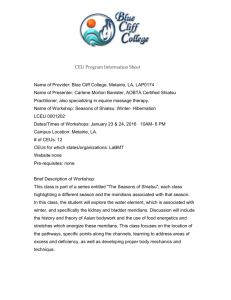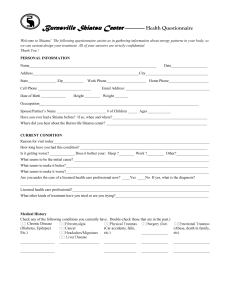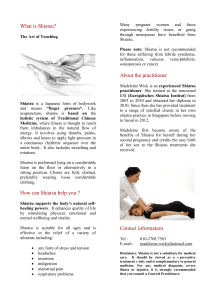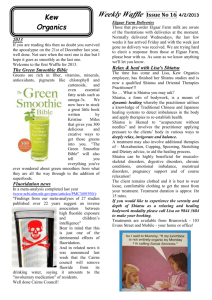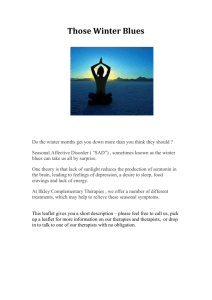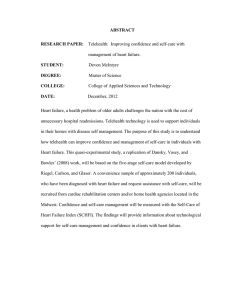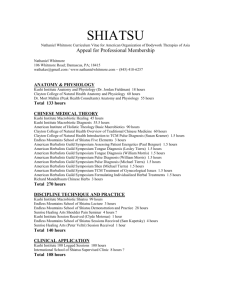HA 101 Eastern Massage I : Assessment Plan and Report ... 1. Catalogue description
advertisement
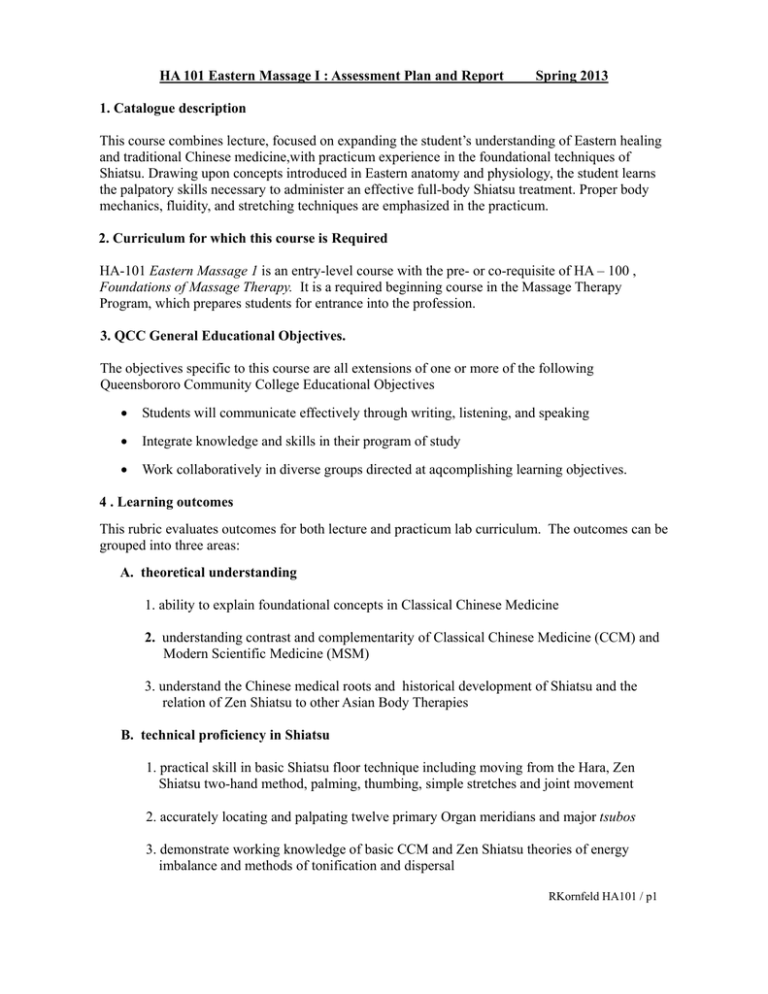
HA 101 Eastern Massage I : Assessment Plan and Report Spring 2013 1. Catalogue description This course combines lecture, focused on expanding the student’s understanding of Eastern healing and traditional Chinese medicine,with practicum experience in the foundational techniques of Shiatsu. Drawing upon concepts introduced in Eastern anatomy and physiology, the student learns the palpatory skills necessary to administer an effective full-body Shiatsu treatment. Proper body mechanics, fluidity, and stretching techniques are emphasized in the practicum. 2. Curriculum for which this course is Required HA-101 Eastern Massage 1 is an entry-level course with the pre- or co-requisite of HA – 100 , Foundations of Massage Therapy. It is a required beginning course in the Massage Therapy Program, which prepares students for entrance into the profession. 3. QCC General Educational Objectives. The objectives specific to this course are all extensions of one or more of the following Queensbororo Community College Educational Objectives Students will communicate effectively through writing, listening, and speaking Integrate knowledge and skills in their program of study Work collaboratively in diverse groups directed at aqcomplishing learning objectives. 4 . Learning outcomes This rubric evaluates outcomes for both lecture and practicum lab curriculum. The outcomes can be grouped into three areas: A. theoretical understanding 1. ability to explain foundational concepts in Classical Chinese Medicine 2. understanding contrast and complementarity of Classical Chinese Medicine (CCM) and Modern Scientific Medicine (MSM) 3. understand the Chinese medical roots and historical development of Shiatsu and the relation of Zen Shiatsu to other Asian Body Therapies B. technical proficiency in Shiatsu 1. practical skill in basic Shiatsu floor technique including moving from the Hara, Zen Shiatsu two-hand method, palming, thumbing, simple stretches and joint movement 2. accurately locating and palpating twelve primary Organ meridians and major tsubos 3. demonstrate working knowledge of basic CCM and Zen Shiatsu theories of energy imbalance and methods of tonification and dispersal RKornfeld HA101 / p1 C. Self-care and professional development 1. using self-care practices to develop awareness and amplification of Ki flow 2. practicing proper hygiene 3. setting up a floor treatment space 5. Methods of evaluation At mid-term and at completion of the 15 week course, each student was evaluated for competency in each objective on a scale of 1-4: needs improvement, developing, proficient, and distinguished. Scores for each objective were summed, enabling relative assessment of success in meeting the objectives for the above nine skills and comparison of progress at midterm and completion. Means of evaluation for Group B were Practical Exams in which students demonstrated skills working in pairs and occasionally groups of three. Also included were meridian lab flash quizzes. Evaluation for Group A was by means of relevant sections of two written exams, a Final Examination, and homework assignments. Means of evaluation for Group C skills were instructor observation during practicum and a short essay homework assignment given in week 14. Criteria for scoring each outcome on the 1-4 scale are presented in Table 1. HA 101 Eastern Massage I SKILLS Evaluation Criteria 4. 3. Distinguished Proficient 2. Developing Spring 2013 1. Needs improvement Discusses and Explain and applies over 90% discuss at least of key concepts 90% key terms Explains at least 50% of key terms Identifies terms, can't explain 2. Understand and articulate history of Shiatsu, relation to CCM roots, relate Shiatsu to other ABTs Presents timeline, explains continuity of all links Presents partial time-line, explains some links Shows awareness of historical development 3. Discuss complimentarity and contrast of Classical Chinese and Modern Scientific Medicine Critically Compares, compares and contrasts in contrasts CCM / several relevant MSM dimensions Theoretical 1. Able to explain, apply foundational Classical Chinese Medical concepts Presents full time-line, explains some links Compares and Identifies contrasts in one areas of relevant difference dimension Practicum Technique 4. Skill in basic Zen Shiatsu (on mat)including: body mechanics, two hand connecting method, palm and thumb, stretches, joint movement, continuity Consistently demonstrates skills with no instructor prompt Demonstrates skills 90 % of time without instructor prompt Consistently demonstrates skills with instructor prompt Occasionally demonstrates skills with instructor prompt 5. Accurately locates, palpates twelve primary Organ channels (meridians) and major tsubos Up to 90% Over 90% accuracy with no accuracy with no prompt prompt Up to 50% accuracy with no prompt Up to 25% accuracy with no prompt 6. Demonstrates working knowledge of CCM and ZS theory of energy imbalance, tonification, dispersal Assesses kyo jitsu,applies appropriate tech 90% Assesses kyo jitsu, applies appropriate technique 75% Assesses kyo jitsu / applies technique up 50% of time Understands but cannot assess/ apply technique 7. Uses self-care practices (meditation, yoga, breathwork, wellness lifestyle) to develop awareness of & amplify Ki-flow Cearly explains value of self-care in Shiatsu, uses methods in and out of classroom Takes responsibility for use of self-care techs in classroom and daily life Diligently uses selfcare in class articulates awareness of own Ki-flow Uses self-care practices in class room activities with prompts only 8. Setting up professional treatment space for working on floor mat Always brings supplies, prepares mat and immediate surroundings neatly and carefully Always brings supplies, prepares mat neatly and carefully, clears surrounding area Always brings supplies, drapes mat, prepares mat neatly and carefully Sometimes brings supplies, drapes mat and prepares space carelessly 9. Practicing proper hygiene Includes: handwashing pre/post, clean uniform, laundering practice sheets, fingernail maintenance, use of scent-free personal care products 100% compliance 100% compliance in handwashing, at least 90% compliance in others listed 100% compliance in handwashing, at least 50% in rest of list Less than 100% compliance in handwashing, soemetimes complies with rest of list Self-care/ Pro Development 6. Use of Information to improve HA101 One of the challenges in this course is to meet objectives in three categories critical to success as an entry-level massage therapist: theoretical understanding , technical proficiency, and self-care/self development. This challenge was amplified when the program cut the number of Eastern classroom hours by 1/3 while requiring essentially the same curriculum to meet the NYS Board Blueprint. The question of how many hours to allot to each of these three areas is a central and constant one in planning the course outlines. Although the sections are clearly divided into 50 minute lecture and 2 hour 50 minute lab, the labs often require additional lecture support for demonstrations, and they usually are where the self-care methods are practiced. Also, HA 101 and 103 are the only courses in the QCC program where CCM or Asian Body Therapy theory is presented and the officially alloted lecture hours are not sufficient since the elimination of the 45 hour Eastern Massage III,ure This necessitates running some lectures into lab hours.The most common complaints in student evaluations of this course have been related to shortened lab time., Breaking out the learning objectives in terms of these categories can generate some statistics to use in assessing how the course as currently outlined and delivered is accomplishing goals across these categories. Some decisions about proportion of hours alloted to each category may arise from the results. Each category has three objectives, leading to a possible total of 4 – 12 points per general topic area. So we can compare sums of all the students across theory, technique, and self-care. The rubric also calls for midterm and final stage evaluation of each objective – we can track each students progress in each outcome and compare across outcomes. We can then investigate outcomes that have no or weak progress from midterm to final stages. The rubric can also be employed by instructors as part of a student midterm evaluation - bringing focus to areas where students may be having difficulty. Most of the learning objectives in HA101 are further developed in HA103 – there is a simple continuum of expected progress in thoeretical understanding, technical skill and professional selfdevelopment. Use of the rubric may also provide a way of recognizing/articulating stages of skills proficiency for HA 101 that can be expanded in HA103. 7. Summary Report Grids for each student appear in an appendix at the end of this report. Only students who completed the class were included. (Two students recieved INC grades). The grid shows midterm and final scores for each skill – noted as M and C scores. Two summary sheets appear on the next pages. The first sums final stage scores (C scores), showing total number of students at each level of competence across the nine outcome skills. A second summary sheet reports percentage of students achieving proficiency (3 pts) or better and percentage of students scoring 2 pts ( developing level) or worse for each of the skills. This statistic was most helpful in analyzing the results. HA 101 Eastern I Spring 2013 Summary - Total Student Score Distribution by Outcome SKILLS 4. Distinguished 3. Proficient 2. Developing 1. Needs improvement 1 11 11 1 2. Understand and articulate history 1 of Shiatsu, relation to CCM roots, relation of Shiatsu to other ABT 3 18 2 1 3. Discuss complimentarity and contrast of Classical Chinese and Modern Scientific Medicine ***totals 9 12 2 Theoretical 1. Able to explain, apply foundational Classical Chinese Medical concepts 3 23 41 5 Practicum Technique 4 4. Skill in basic Zen Shiatsu (on Including: body mechanics,two hand connecting method, palm and thumb, stretches, joint movement,continuity 13 7 0 5. Accurately locates, palpates twelve primary Organ channels (meridians) and major tsubos 14 8 0 1 22 2 2 0 6. Demonstrates working knowledge of CCM and ZS theory of energy imbalance, tonifification, dispersal ***totals 6 28 37 2 Self-care/Professional Development 9 9 4 8. Setting up professional treatment 4 space for working on floor mat 18 2 0 9. Practicing proper hygeine 18 3 0 7. Uses self-care practices to develop awareness and amplification of Ki ***totals Summation / Total # score : 2 3 9 18 45 96 14 75 4 10 HA 101 Eastern I Spring 2013 SKILLS by percentage Summary: % at Proficiency Level by Outcome Proficient or higher Developing or lower Theoretical A1. Able to explain and apply foundational Classical Chinese Medical concepts 50% 50% A2. Understand and articulate history of Shiatsu, relation to CCM roots, relation of Zen Shiatsu to other ABT 35% 65% A3. Discuss complimentarity and contrast of Classical Chinese Medicine and Modern Scientific Medicine (Biomedicine) 16 % 84% B1. Skill in basic Zen Shiatsu (on mat) Including: body mechanics,two hand connecting method, palm and thumb, stretches, joint movement,continuity 71% 29% B2. Accurately locates, palpates twelve primary Organ channels (meridians) and major tsubos 68% 32% B3. Demonstrates working knowledge of CCM and ZS theory of energy imbalance, tonifification, dispersal 04% 96% C1. Uses self-care practices to develop awareness and amplification of Ki-flow 46% 54% C2. Setting up professional treatment space for working on floor mat 88% 92% C3. Practicing proper hygeine 92% 08% Practicum Technique Self-care/Professional Development Highlights and analysis 1. All students C scores progressed from M scores across all objectives. 2. Overall, the least successful outcome was #3 in the technical skills division: B3 - demonstrate working knowledge of CCM and Zen Shiatsu theories of energy imbalance and methods of tonification and dispersal No student scored higher than C2 here, although almost all progressed from M1. This is really a more advanced skill a main focus in HA103. This objective needs to be stepped down and retained for competency in HA103, which applies HA101 skills in assessment and treatment planning. Working knowledge should be replaced with something along the lines of can explain the energetic effect of basic techniques in terms of tonification and dispersal, and demonstrate them. 3. With B3 removed from the analysis, the technical skills outcomes were the most successful of the three areas, with 71% and 68% reaching proficiency as here defined. 4. The second least successful outcome was in the theory area, with only 16% at proficiency A3 Discuss complimentarity and contrast of Classical Chinese Medicine and Modern Scientific Medicine (Biomedicine) This is conceptually difficult for most students, especially those who do not have the prerequisite A&P I under their belts before they arrive. HA 103 further develops this theme, so there is more exposure to this topic. Its important for understanding how Asian Body Therapy skills can fit into emerging integrative health practices. 5. Only 18 scores at the Distinguished level ( 4 ) were recorded. Most of the skills across all categories are further developed in HA103 and it is highly unusual for students to progress to this level in what amounts to 30 – 60 minutes of hands on practice (technical level) per week. On the theoretical level, the conceptual frameworks are very challenging if we try for authentic understanding of the paradigms at work in CCM and Zen Shiatsu and clarity of comprehension. Thorough evaluation of the success of the theory area of program objectives would need to include HA103 – to see if HA 101 is providing an adequate platform with 93% of all theory C scores at Developing (2) or above. Detailed analysis of three key outcomes An analysis of the results on three key objectives is presented here. Each objective is the most important (#1) in its group. A 1 (Theoretical Understanding) Ability to explain foundational concepts HA101 presents students with the challenge of understanding key concepts of Traditional Chinese Medicine and their adaptation into a foundation for the practice of Shiatsu. The target outcome here is an ability to make the concepts relevant to their own health as well as to their clients in their future work as massage therapists, not simply abstract understanding. This was assessed based on a short essay question appearing on the Final Examination, several short answer questions on Exam #1, and students ability to use CCM and Shiatsu terminology in discussion and lab. Overall grades on the theoretical component of the Exams were also used as means for evaluating progress towards this outcome. In Spring 2013, the primary reading for this area was rough draft chapters of the instructor's book Shiatsu for Massage Therapists: Adjunctive and Integrative Application. The main didactic presentation of a framework for comparing CCM and MSM (Modern Scientific Medicine = Biomedicine) occurs in the first two weeks. The short essay charge was: How has your thinking about health and illness changed as a result of your study of Shiatsu and Classical Chinese Medicine.? Can you describe three specific ways that your understanding or attitudes have changed? For each of these three, explain what aspect of CCM or Shiatsu theory accounts for your new perspective. 50% of the C scores were at least at proficiency level, but only one student did not reach the development (2) step, so almost 100% made step 2. Presenting a question similar to the one above as a homework earlier in the semester could be helpful here, rather than waiting for the Final Exam. B 1. (Technical Proficiency) Practical skill in basic Shiatsu floor technique The Final Practicum Exam evaluates these core skills – the instructor observes and grades 45-60 minutes of work by each student, assessing body mechanics, no-force technique, two-hand (Mother/Son) technique, etc. The midterm evaluation is based on ungraded observation during lab practice of the weekly lessons. At various points in the semester, the instructor also has students demonstrate tsubo location and techniques on him/herself. Ability to master a basic sequence of application is also required and included in the scoring. 71% of the C scores on this skill were Proficiency (step 3) or better. All students made Step 2 here. The Proficiency criteria are rigorous here: moving from Hara, (the core of Shiatsu body mechanics,) consistently applying the foundational Zen Shiatsu "Mother Hand" technique, femoral and humeral joint rotations, stationary thumb and digital compression – all have to be shown on the Practical Final with no more than 10% instructor prompt. This is a high bar, and 71% is a good showing. The seven students at the Development level should have an adequate basis to step up to Proficiency in HA103. The companion skill, B2 – accurate meridian and tsubo ("point") work – completes the basic practicum component on HA101. Scoring on this outcome was similar, with 68% at Level 3 or better and the remaining at Level 2. C 1. (Self-care and professional development) Uses self-care practices to develop awareness and amplification of Ki flow Evaluated by quality of participation in instructor-led breathing, stretching,and meditation training that preceded hands-on practice in the first 6 lab sessions. Some students get the value of this right away, while some initially "mail it in", with their minds elsewhere. At the end, evaluated by relevant segments of the Final Practical Exam: Professional Presentation: calm, centered, ready to work maintains consistent focus Also evaluated by means of a homework assignment in week 13 that looks for the student to directly connect these practices to the quality of the work given and received in the practicum. How would you describe the best that you've felt after receiving practice work? Think about physical, emotional, and Shen (mental-spiritual ) levels. What factors do you think contribute to your recieving a better session? These could be the way in which your partner worked and/or how you were at the time. Can you discuss three of these factors in order of priority? Learning effective self-care is a career-long skill that requires training in "tuning in" to one's own Ki as well as intuitive connection with their practicum receivers. Instructors encourage students to use the breathing, non-sectarian meditation, and other exercises (yoga, taiji, qigong) to put together home routines. Discussion of students experiences and progress is encouraged in the lab sections. These results, 46% at Proficiency (C score 3 or better) were disappointing. Four students (out of 24) were stuck at Level 1, the most for any objective. The evaluation of this skill relied heavily on response to the homework charge above, looking for the student to articulate the connection between practicing meditation, breathing, yoga, etc and the quality of the work given and received. An additional way to evaluate would be to assign a brief written diary or log of their self-care practice progress. 9. Suggestions for improving course The technical skills outcomes are being met, although students are usually clamoring for more lab and less lecture time. The self-care aspect needs to be given more formal attention. One remedy is to continue the guided practice of self-care methods in the lab sections beyond the mid-term. The first six labs all had at about 15 minutes of instructor led practices. This was less consistent in the second half of the semester, and not included at all in the last four labs to make room for more practice time. Even 5 or 10 minutes of guided mediatation, breathing should be continued. A brief period after the lab would be useful for helping them tunt in to the energetic effects of the work. More tuning in experiences are needed. More conceptual structure needs to be given to help them critically compare/contrast the two medical paradigms. Slightly more weight needs to be given to historical framework in lecture and exams. 10 . Suggestions for improving rubric The practical skill outcome B1 needs to be divided into several categories – body mechanics can be its own outcome. Moving and stationary techniques could be broken out into separate categories. Outcome B3 needs revision as discussed above. In general, the rubric fared well in identifying strengths and weaknesses in the course as taught in Spring 2013. RKornfeld HA101 / p4
